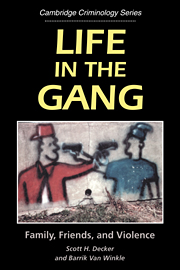Book contents
- Frontmatter
- Contents
- Acknowledgments
- Preface
- Chapter One Life in the Gang: Family, Friends, and Violence
- Chapter Two “Are You Claiming?” Methods of Study
- Chapter Three “I'm Down with the Bloods, What's up Cuz?” Membership Issues
- Chapter Four “We Ain't No Worldwide Thing or Nothing”: Gang Structure and Relationships
- Chapter Five “Where You Hanging? Let's Go Banging”: What Gang Members Do
- Chapter Six “I Love to Bang”: Serious Crime by Gang Members
- Chapter Seven “Doing Time” in School and Elsewhere: Gang Members and Social Institutions
- Chapter Eight “My Mom Doesn't Know”: Gang Members and Their Families
- Chapter Nine “There's Only Two Ways to Leave the Gang, Die or Move”: Responding to Gangs
- Notes
- References
- Index of Gang Members, Relatives, and Ex-Members
- Subject Index
Chapter Eight - “My Mom Doesn't Know”: Gang Members and Their Families
Published online by Cambridge University Press: 05 June 2012
- Frontmatter
- Contents
- Acknowledgments
- Preface
- Chapter One Life in the Gang: Family, Friends, and Violence
- Chapter Two “Are You Claiming?” Methods of Study
- Chapter Three “I'm Down with the Bloods, What's up Cuz?” Membership Issues
- Chapter Four “We Ain't No Worldwide Thing or Nothing”: Gang Structure and Relationships
- Chapter Five “Where You Hanging? Let's Go Banging”: What Gang Members Do
- Chapter Six “I Love to Bang”: Serious Crime by Gang Members
- Chapter Seven “Doing Time” in School and Elsewhere: Gang Members and Social Institutions
- Chapter Eight “My Mom Doesn't Know”: Gang Members and Their Families
- Chapter Nine “There's Only Two Ways to Leave the Gang, Die or Move”: Responding to Gangs
- Notes
- References
- Index of Gang Members, Relatives, and Ex-Members
- Subject Index
Summary
THERE IS LITTLE systematic research that examines the link between family characteristics, values, and processes and gang membership. Some speculate that female-headed households make it more likely that young men will decide to join gangs, and that the decision to join a gang represents an attempt to find male role models unavailable in the nuclear family. An alternative suggestion holds that many urban families are unable to provide for the basic economic needs of their children and that gangs fulfill that need. Yet other approaches emphasize that adolescence is a time of increasing independence from the family, when family ties are weakened and those to peers and street culture become stronger. In each case, however, there is much more speculation than actual research.
We believe it is important to understand gang members and their families in the context of the neighborhoods they live in. By and large, the members of our samples lived in neighborhoods with few resources. Schools were plagued with difficulties (created in part by members of our sample), housing stock had declined, jobs in the legitimate economy had vanished, and recreation opportunities were hard to find. But not only had the power of formal social institutions been eroded, other mechanisms had lost their ability to control the behavior of neighborhood residents as well. Key among this latter group were neighborhood social control and the family. Viable neighborhoods, with functioning legitimate opportunity structures, go a long way to provide effective controls on behavior, especially for young people.
- Type
- Chapter
- Information
- Life in the GangFamily, Friends, and Violence, pp. 230 - 260Publisher: Cambridge University PressPrint publication year: 1996



